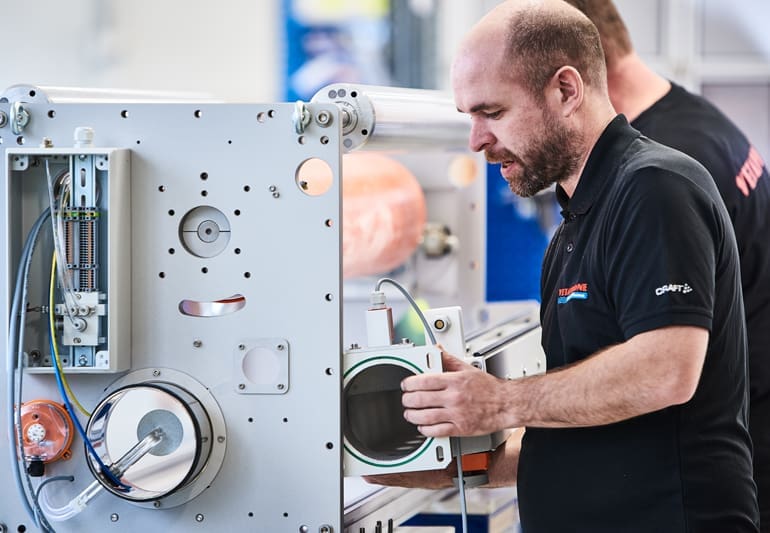At a time when the very word ‘corona’ sends shockwaves around the world, Vetaphone is sensitive to its more customary use in the print, laminating, and extrusion markets, where surface treatment is a vital element in daily production. Kevin McKell, our Vice President of Technical Sales, explains why Total Cost of Ownership (TCO) is so important when choosing surface treatment technology?
Why should companies take the longer view when choosing which surface treatment technology to buy?
Because the purchase price is only a part of the overall investment – and this is a trap that many converters and extruders fall into. They look only at the bottom line of the quote to see how much it’s going to cost to buy, and completely forget to factor in the on-costs that occur with any machine or item of technology.
What’s the first additional cost to consider?
Installation of course! It’s no good buying the cheapest equipment if you (or someone) needs to spend a lot of time assembling and installing it once it arrives. That’s why we ship all of our surface treatment units for a turn-key installation. All parts are completely pre-assembled and pre-wired so that it’s easy and quick to integrate into the production line with minimal disruption and cost. All our customers need to do is to mechanically install an air/ozone outlet and ensure there is an electrical connection.
What other factors do they need to take into account?
Bearing in mind how harsh some of the working environments are, customers need to evaluate the life expectancy of the unit given its intended usage in their plant. All Vetaphone corona equipment is built from the best materials for continuous production in any working environment. Crucially, all parts are ozone resistant. The design has been continually refined over the years using experience drawn from our many worldwide installations. These include cold to hot climates as well as regions with low and high humidity. Our latest technology is proving extremely reliable, making it perfect for 24-hour production and a long working life.
What sort of problems stem from poor build quality?
Poor quality components and poor build quality cause major problems in any production line – it’s not just an issue with surface treatment. But, you don’t want your corona unit to be the weak link in the chain. Cheaper units will break down more often, causing a loss of production and they won’t last as long, meaning further investment and disruption as the replacement is installed and commissioned. One of our OEM’s says that the reason they fit Vetaphone corona units is because they last up to five times as long as cheaper units.
How do Vetaphone units prevent loss of production?
One of the reasons for a fall in production is non-uniform surface treatment across the width and along the full length of the web. This doesn’t happen with a Vetaphone corona unit because of our automatic power density device. This allows the generator to raise or lower the corona power setting automatically according to the line speed, ensuring the same treatment is applied per square metre throughout the run. The generator automatically starts and stops with the production line and will ‘flag’ situations that are outside of its capability.
Is Vetaphone technology integrated into the line control?
Yes, it is. Vetaphone provides an interface between the corona unit and production line, whether it is a printing press, laminator or extruder. This allows the operator to make adjustments, read data and see any ‘flagged’ issue. Our latest iCorona generators also feature the unique iCC7 control panel, which has been available since 2017 and we believe takes Vetaphone beyond Industry 4.0.
What’s so special about iCC7?
It’s designed to make the technology easy to understand and intuitive to use. It collates and utilises feedback from operators who use the technology in a commercial environment on an everyday basis. We keep the front page of the iCC7 display simple, with optional in-depth sophistication that allows the operator to explore more detailed information as required. It logs function and maintenance requirements, with remote analysis via a download tool and USB port.
All technology has downtime – how does Vetaphone resolve this issue?
Our equipment is built for high production security. Its design and modular construction make it easily accessible so downtime related to maintenance, repair, or upgrade can be kept to a minimum. The entire encapsulated generator module can be easily accessed and quickly exchanged from Vetaphone’s worldwide support centres, if necessary. The corona treater station is built with an electrode system in a removable pull-out/push-in quick change cartridge for easy maintenance and cleaning. This ensures minimum downtime and increased productivity. On our larger corona stations, the electrode assemblies are pneumatically activated and pivot away for easy access.
What about the cost of spare parts?
The thing to remember is the importance of using original spare parts, not cheaper copies. Our parts department is always available to provide you with the right part at the right price. This will ensure sustained performance from your Vetaphone technology and a longer working life. Our equipment is well documented, which makes wearing parts and spares parts easy to identify and order. We typically provide spare parts for 20 years after the original Vetaphone equipment is sold and offer global technical support and a support hotline to solve problems instantly.
Finally, how do you keep running costs down?
As energy costs continue to rise and environmental issues become more prominent in our daily lives, Vetaphone is constantly on the lookout for ways to become ‘greener’. Maximum performance with minimum impact is something of a mantra for us. That’s the reason our generators use the Vetaphone patented resonance circuit. This ensures maximum energy reaches the electrodes and less of it is lost in heat in electrodes and in the electronics. All of which means that our equipment provides more dyne/kW.

